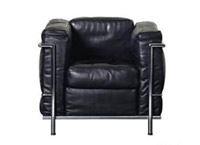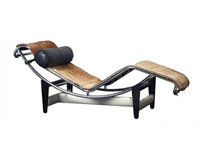
Heidi Weber makes all four Le Corbusier
chairs accessible to the public for the first
time; the Le Corbusier prototypes
from 1929 were adapted by her for
industrial, serial production.
Shortly after her first meeting with Le Corbusier in August 1958 in Cape Martin, Heidi Weber met him again on 2 September in Paris. They decided that she starts the production of his four chairs and the sale of his art works.
Upon her return to Zurich, Heidi Weber began immediately to organise a small studio factory to start on 1 October with the production of the four chairs. As she did not have any original models as reference, she was forced to rely on a series of drawings which Le Corbusier sent her. Heidi Weber was able to draw on her considerable experience as an interior designer to help realise this furniture.
Previously, in 1929, the two models “Chaise-Longue” (LC 104) and “Dos Basculant” (LC 103) were taken into production by Thonet, a well-known firm for commercial furniture. However, at this point the two models were not destined for success and there were only few sales, which ultimately forced the company to stop production. The models “Grand Confort” LC 101 and LC 102, were not even produced only some prototypes were realised by Thonet.
Without these two Fauteuils, the collection was incomplete or, to be more precise, there was in fact no collection. There were only two models and Le Corbusier's furniture project was literally reduced to these individual pieces.
With Heidi Weber's additional production of the two “Grand Confort” models, the four chairs became a collection which could fill an entire room arrangement just as Le Corbusier had originally planned.
Le Corbusier was impressed by Heidi Weber's enthusiasm for his furniture and by her dynamism. Within three months of receiving the blueprints, she was able to invite him to view the first serial models. Rather than rough prototypes, she was able to show him the first production run of twenty-five of each of the four models which had all been produced in her little workshop. Le Corbusier was surprised and excited, his only recommended correction was a hardly noticeable shortening of the front arm-supports of the “Dos Basculant”.
Le Corbusier signed the first contract for the production rights with Heidi Weber on 1 December 1959. This was after he had written to her a few months previously: “I will sign a contract with you, but, first of all, I want a proof of your capability.” With this first contract he granted her the rights for Europe and the USA for three years. On 1 January 1963, the same contract was ratified, extending the period to fifteen years to 1978. This time including the rights for South America.
The Production run smoothly and sales were extremely successful – orders were coming in from New York, Hong Kong and from other parts of the world – so much so that Heidi Weber was forced to make an important decision. Her small workshop was working to full capacity and she would not really be able to meet the steady increase of worldwide demand. At this point, she was forced to choose whether she wanted to stay in the furniture business or whether she would prefer to outsource her production and sub-license it to a well established furniture production company.
Cassina S.p.A. a family business in the town of Meda near Milan was one of the many potential licensees. Run by Franco Cassina, this company had been focusing on a limited sector of the furniture market. They specialised in producing wooden interiors for ships and hotels. To break out of this closed market, they needed a new line of furniture and a consumer brand. Heidi Weber convinced their directors that by manufacturing Le Corbusier's furniture they would make an important strategic move to capture the attention of an entirely new consumer group. After long negotiations, Heidi Weber signed a sublicense contract with Cassina S.p.A. on 23 October 1964 which granted them the production and distribution rights for Italy. This license was extended to include Europe in July 1965 and, one year later, Heidi Weber extended this sublicense again to include the USA.
Le Corbusier had no interest in meeting the sub-licensee, and left the decision process entirely to Heidi Weber. As far as he was concerned, they worked for Heidi Weber. With typical conscientiousness, she made it her task to implement strict quality controls whilst offering Cassina her support and the benefits of her considerable experience. It is regrettable that after the death of Le Corbusier on 25 August 1965 and when her original contract with him ran out in 1978, Heidi Weber was no longer able to exert any influence over the production. Unfortunately the contributions of Heidi Weber were not properly valued nor was the original contract between the two not taken over after 1978 by the Le Corbusier Foundation in Paris, his estate administrators.
It is also important to note that Heidi Weber always respected the conditions and the spirit of the contract with Le Corbusier in 1959 and 1962, namely to only produce four models, by his own inventions. During the fifteen years of her contract with Le Corbusier, she never produced any other models and for sure she would have never accepted to produce any new models based on some sketches apparently found after his death at the Le Corbusier Foundation in Paris.
Heidi Weber's achievements are manifold. One of the most important ones was convincing Le Corbusier that his furniture was not old-fashioned, but in fact the most contemporary and modern furniture of the twentieth century.
Her greatest contribution to the serial production was the quality manufacturing and her aesthetic alterations to the models which completed the collection. This played a decisive role in the ongoing worldwide success of the Le Corbusier furniture collection whitch continues until today.



